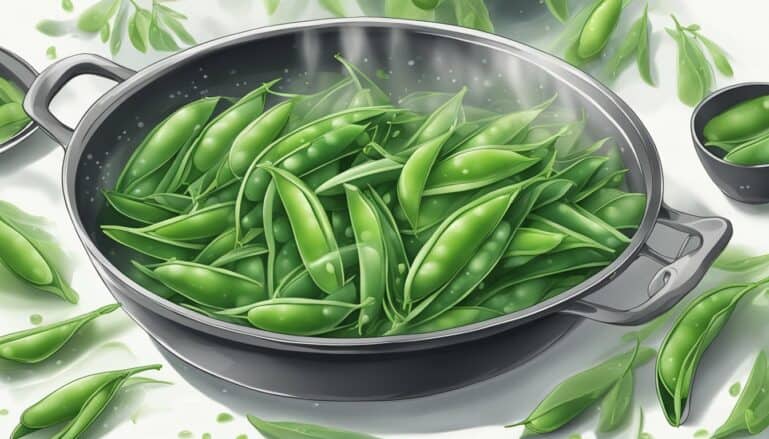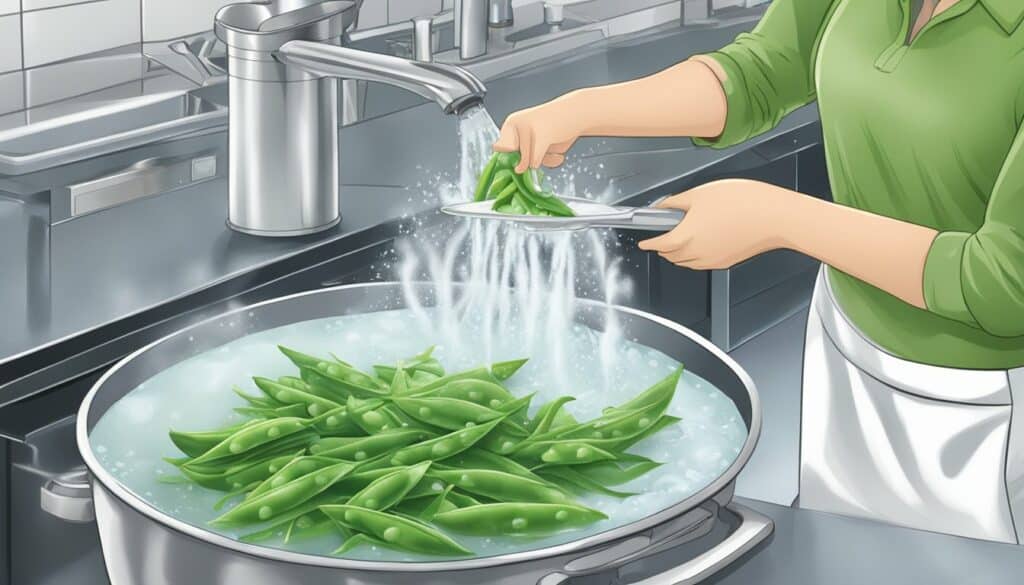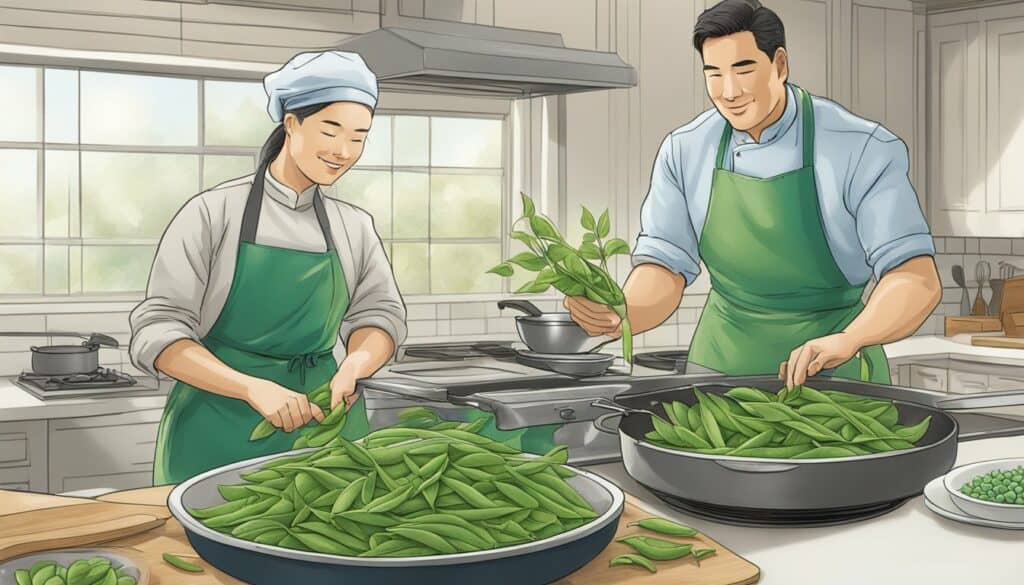How to Cook Snow Peas: A Simple and Delicious Recipe Guide

Table of Contents
Understanding Snow Peas
Snow peas are a type of legume that are commonly used in Asian cuisine. They are also known as sugar snap peas or Chinese pea pods. Snow peas are flat and have a thin, edible pod that is filled with small, tender peas.
When selecting snow peas, look for pods that are bright green, firm, and free from blemishes. The peas inside should be small and plump. Snow peas are best eaten fresh and raw, as cooking can cause them to lose their crisp texture and sweet flavor.
Snow peas are a great source of vitamins A and C, as well as fiber and protein. They are also low in calories and fat, making them a healthy addition to any diet.
To prepare snow peas, simply wash them in cold water and trim the ends. They can be eaten raw as a snack or added to salads for a crunchy texture. Snow peas can also be quickly blanched or stir-fried for a delicious side dish.
Overall, snow peas are a versatile and nutritious vegetable that can be enjoyed in a variety of ways.
Preparation of Snow Peas
To prepare snow peas, start by rinsing them under cold water in a colander. Then, use a pair of kitchen shears to trim off the stem end and remove the string that runs along the length of the pod.
Next, cut the snow peas into bite-sized pieces or leave them whole, depending on your preference. If you plan to sauté or stir-fry the snow peas, it’s best to cut them into smaller pieces for even cooking.
After cutting the snow peas, place them in a colander and give them a quick rinse under cold water. Then, gently pat them dry with a paper towel or kitchen towel before cooking.
When preparing snow peas, it’s important to handle them gently to avoid damaging the delicate pods. With these simple steps, you can quickly and easily prepare snow peas for a variety of delicious dishes.
Cooking Methods for Snow Peas
Snow peas are a versatile vegetable that can be cooked in a variety of ways. Here are some popular methods:
Blanching Snow Peas
Blanching is a quick and easy way to cook snow peas while preserving their bright green color and crisp texture. Here’s how to do it:
- Bring a pot of salted water to a boil.
- Add the snow peas and cook for 1-2 minutes, until they turn bright green and are crisp-tender.
- Drain the snow peas and immediately transfer them to a bowl of ice water to stop the cooking process.
- Drain again and pat dry with a paper towel.
Sautéing Snow Peas
Sautéed snow peas make a delicious and healthy side dish. Here’s how to do it:
- Heat some oil (olive oil, butter, or coconut oil) in a hot skillet over medium-high heat.
- Add some minced garlic and cook for 30 seconds until fragrant.
- Add the snow peas and sauté for 2-3 minutes until they are tender but still crisp.
- Season with salt and pepper to taste.
Stir-Frying Snow Peas
Stir-frying is a popular method for cooking snow peas in Asian cuisine. Here’s how to do it:
- Heat a wok or large skillet over high heat.
- Add some oil (olive oil, sesame oil, or toasted sesame oil) and swirl to coat the pan.
- Add some minced garlic and ginger and stir-fry for 30 seconds until fragrant.
- Add the snow peas and stir-fry for 1-2 minutes until they are tender but still crisp.
- Season with soy sauce, Sriracha, or other seasonings to taste.
Steaming Snow Peas
Steaming is a gentle and healthy way to cook snow peas. Here’s how to do it:
- Bring a pot of water to a boil and place a steamer basket over it.
- Add the snow peas to the steamer basket and cover with a lid.
- Steam for 2-3 minutes until they are tender but still crisp.
- Season with salt and pepper to taste.
Overall, there are many ways to cook snow peas, and each method offers a unique flavor and texture. Experiment with different techniques to find your favorite!
Seasoning and Flavoring
When it comes to seasoning and flavoring snow peas, there are a variety of options to choose from. Here are a few of my favorite ways to add flavor to snow peas:
- Salt and pepper: A classic combination that can’t go wrong. Simply sprinkle some salt and pepper onto the snow peas before cooking for a simple yet flavorful dish.
- Garlic: Adding minced garlic to the snow peas while cooking can add a delicious savory flavor.
- Lemon: Squeezing fresh lemon juice over the snow peas after cooking can add a bright and tangy flavor.
- Basil and parsley: Chopped fresh herbs can add a fresh and aromatic flavor to the snow peas.
- Soy sauce: A small amount of soy sauce can add a savory umami flavor to the snow peas.
- Sesame: Toasted sesame oil or seeds can add a nutty and slightly sweet flavor to the snow peas.
- Ginger: Grated fresh ginger can add a spicy and slightly sweet flavor to the snow peas.
Experiment with different combinations of these flavors to find your favorite way to season and flavor snow peas. Remember to taste as you go and adjust seasoning as needed.

Incorporating Snow Peas into Dishes
As a versatile vegetable, snow peas can be incorporated into various dishes, from salads to stir-fry. Here are some ways to use snow peas in your cooking:
Snow Peas as Side Dish
Snow peas make a great side dish that complements a variety of main courses. To prepare them, remove the ends and strings, and blanch them in boiling water for 1-2 minutes until they turn bright green and crisp. Then, toss them with lemon juice and olive oil, and season with salt and pepper.
Snow Peas in Salads
Snow peas can add a refreshing crunch to salads. To use them raw, remove the ends and strings, and slice them thinly. Then, mix them with other vegetables such as broccoli and carrots, and dress with a simple vinaigrette made with lemon juice, olive oil, and Dijon mustard.
Snow Peas in Stir-Fry
Snow peas are a popular ingredient in stir-fry dishes. To prepare them, remove the ends and strings, and slice them diagonally. Then, sauté them with other vegetables such as bell peppers and onions, and protein such as chicken, shrimp, or tofu. Season with soy sauce and sesame oil for a savory flavor.
Snow Peas with Seafood
Snow peas pair well with seafood such as shrimp and fish. To prepare them, remove the ends and strings, and sauté them with garlic and olive oil until they turn bright green and crisp. Then, add the seafood and cook until they are done. Season with lemon juice and salt for a fresh taste.
In summary, snow peas are a versatile and flavorful vegetable that can be used in various dishes. Whether you prefer them blanched, steamed, or stir-fried, snow peas are a great addition to any meal.
Nutritional Value of Snow Peas
Snow peas are a great addition to any diet because of their high nutritional value. They are low in calories, fat, and carbohydrates, making them a great choice for those who are watching their weight. One cup of snow peas contains only 35 calories and less than 1 gram of fat.
Snow peas are also a good source of protein and fiber. One cup of snow peas contains 2 grams of protein and 2.5 grams of fiber. This makes them a great choice for vegetarians or anyone looking to increase their protein and fiber intake.
In addition, snow peas are rich in vitamin C, calcium, and iron. One cup of snow peas contains 48% of the recommended daily intake of vitamin C, 4% of the recommended daily intake of calcium, and 6% of the recommended daily intake of iron.
Here is a table summarizing the nutritional value of snow peas:
| Nutrient | Amount per 1 cup |
|---|---|
| Calories | 35 |
| Fat | <1g |
| Protein | 2g |
| Fiber | 2.5g |
| Carbohydrates | 7g |
| Vitamin C | 48% DV |
| Calcium | 4% DV |
| Iron | 6% DV |
Overall, snow peas are a great addition to any diet due to their high nutritional value and low calorie content.

Storing Snow Peas
To keep snow peas fresh, it’s important to store them properly. Here are some tips for storing snow peas:
-
Whole snow peas should be stored in a plastic bag in the refrigerator. They will stay fresh for up to five days if kept in this way.
-
Refrigerated snow peas should be used within a day or two of purchase. They can be stored in the refrigerator in a plastic bag or container.
-
Frozen snow peas should be stored in the freezer in an airtight container or freezer bag. They will last for up to six months if stored properly.
It’s important to note that snow peas are best when they are fresh, so it’s best to use them as soon as possible after purchasing. If you do need to store them, following these tips will help to keep them fresh for as long as possible.